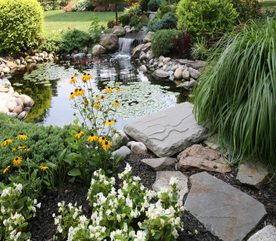Landscape Design: Make Your Own Water Garden
The sight and sound of water, the colourful fish and varied plants water can support, and the vitality of the birds that come to drink add welcome life to any garden. Adding a water garden gives you the opportunity to grow plants that would not survive in regular soil.

Making a Water Garden
Making a water garden is a fasci- nating adventure. Whether you live in a mansion surrounded by hectares of land, or in a townhouse with a small yard, you can still enjoy the pleasures of water gardening. The smallest garden can have a pool or waterfall and even a city terrace can probably accommodate a container large enough to sustain a water lily, some smaller plants, and a few fish. Pygmy water lilies can be used for extra-small spaces, as they will thrive in a container only 60-90 centimeters across and equally deep.
Water is heavy, therefore pools large enough to contain plants and fish are not generally practical for apartment balconies. You can, however, still enjoy the sounds of moving water. Small fountains and water-falls with a built-in pump are readily available and add sight and sound to the smallest space.
Types of Houses and Water Gardens
In small townhouse gardens, half wine barrels can be used, but, if new, should have a liner installed to prevent residues from the barrel-they could be toxic to plants and fish-leaching into the water. Half of a heavy-duty garbage can buried in the ground also makes a good small pool. Either use them for growing water plants in the normal way, or, with a small submersible pump feeding a bubbler-type fountain head and a grating over the top covered in rounded cobbles, you have an attractive feature at little expense.
In a city garden there will often be space to sink a preformed pool of fiberglass into the ground. Then, with the aid of a small submersible pump connected to an electrical outlet, a fountain or waterfall can be created. The same water is used over and over again; so the only running cost is for electricity-a small pump uses only about as much energy as one 75-watt light bulb.
Larger gardens, of course, provide greater scope. Water can be used with rocks to form a pool. Or a cascading chain of pools connected by a running stream can be created with the aid of a pump. The same pump can be adapted to make a fountain or a decorative spray in a variety of patterns or even to handle several different features simultaneously.
Concrete pools are rarely built anymore. They tend to develop leaks as the soil settles beneath them and, in cold climates, to crack from alternate freezing and thawing. Most pools today are built with preformed fiberglass shells or heavy-duty plastic liners, designed specifically for the purpose. Plastic liners are also used to line existing concrete pools that have been damaged. Liner material is available from garden-supply mail-order catalogs and water-garden specialists in sizes suitable for pools of almost any dimension.
Pleasures of a Water Garden
One of the great pleasures of water gardening is growing a wide variety of unusual plants. Elegant day-blooming and night-blooming water lilies-the undisputed aristocrats of water plants-can be cultivated in the deep water of a pool. So can the fascinating oxygenating plants, some of which float on the surface of the water and others of which grow completely underwater. Several interesting plants-including one of the most dramatic of all plants, the lotus-thrive in the shallow water around the edges of a pool. And finally, a large group of attractive bog plants do well in the moist soil adjacent to a pool or stream.
All water gardens need plenty of light if the plants are to flower. No more than two-thirds of the surface of a pool should be covered by lily pads or other plants. The patches of open water will reflect the sky, sparkle in the sunlight, ripple in the wind, and reveal the movement of the fish.
To keep the water in a pool clear, a balance between plant and animal life must be established and maintained. If this is not done, the pool will become murky and fish may die.
The cause is algae, microscopic plants that thrive in sunlight and feed on mineral salts in the water. Most of these salts are produced by the breakdown of organic material, such as leaves, twigs, and other debris. It is therefore essential to keep the pool free of leaves and to be quite sure that the soil on the bottom contains no humus.
It is impossible to keep all foreign organic material out of a pool, but the water can be kept clear by growing oxygenating plants. These plants starve out algae by taking up the mineral salts, and they create shady pockets that diminish the sunlight algae need.
In addition to controlling algae, oxygenating plants take in the carbon dioxide given off by animal life in the pool and-as their name implies-release oxygen into the water. Thus, an efficient cycle is established, plants and animals each making use of the other’s waste.
Fish and Water Gardens
Fish not only enhance the appearance of a water garden but they also keep down the mosquito population by feeding on the larvae. They consume small snail eggs, aphids, and caddisworms, and eat a certain amount of algae and submerged vegetable debris.
The most satisfactory fish for garden pools are the golden orfe, and varieties of goldfish, including comets and shubunkins. These fish are brightly coloured, stay near the surface, and-with a little patience-can be trained to come for food.
Most dealers in fish also sell snails and tadpoles, which help keep a pool clean by eating algae. Tad- poles eat other debris as well, and they turn into frogs and toads- useful garden occupants that consume incredible numbers of insects.
Read more Reader’s Digest backyard landscaping ideas.



